Ohana generally percolates on aloha, the Hawaiian ideal of love and compassion. “I for one don’t think that I could describe it [aloha],” she says. I think it’s in the person. I think you are blessed with it or you aren’t. They like to say it’s caring and sharing, but I say, no, you folks missed the most important part—loving and caring and sharing. You have to love in order to care and share. To me it’s all three.
Kapeka Chandler as told to MJ Harden, “Voices of Wisdom,” 1999
Eight silver gongs for playing kulintang perched on green-colored wood frames caught my eye, while a multi-striped woven fabric with green, lavender and brown, and purple dominant hues casually draped it. Eight is a symbol of infinity. A crown made of white and yellow petals, with protruding green leaves conveyed a sense that folks dance in this house. Wearing an orange blouse and a blue denim shorts, Carol Ojeda-Kimbrough greeted me with her big warm smile and a tight hug.
On Facebook, Carol has been sharing photos of her cactus, her plumerias, her compost with earthworms, including how she and a group of gardeners started repurposing a portion of the city’s sidewalks in Historic Filipinotown, to become inviting rows of plants.
She took me to her backyard teeming with orange citrus fruits (oranges and calamansi), blending well with her orange blouse. Ripe red pomegranate fruits, on the verge of bursting, are on her dining table. The backyard’s bay leaf tree has grown beyond the roof lines. Contrasting are struggling ampalaya plants, white squash vines, slow and dormant, following its earlier season of blooms.
Plumerias are in bloom: white, yellow and pink flowers, reminiscent of Hawaii. Air plants and orchids are stapled onto charcoal tree bark, while cactus of different heights: chubby short, medium robust and tall and lanky, are nesting in a clay pot. Earthworms moved on a pile of compost: raked leaves, dried flowers, fruit peels, vegetable pieces.
Could it be that Mother Nature is delighted, that seeds and sprouts are allowed to grow and bloom? That day was dreary, gray and overcast, perhaps a prelude to what Carol was about to share, a life of grays in it, but also, a sunshine bright life in America.
“Gardening is like teaching, you think of planting seeds, some will sprout, some will do well, some will not. Some, no matter what you do, zero. So, do the best you can, and you put your energies [teaching] those who need help. Same as plants, with 10 seeds [planted], some will sprout, some will lay dormant,” she philosophized.
New beginnings in America
Carol is the eldest of Asuncion Diaz and Pedro Ojeda’s six children — Maria Teresa, Pedro Jr., Maria Asuncion, a FASO musician, Rafael, and Beatriz Rosa. She has children of her own (Andrei, Daniel and Sarah) and her first granddaughter (Te Awhina Toia) and married to her “fave Dave,” a moniker for David Kimbrough, her husband of 33 years.
She grew up in Project 4, Quezon City, near Labor Hospital, now known as Quirino Medical Center. She went to St. Bridget’s in elementary. She transferred to Philippine College of Commerce Laboratory High School where she was trained to think imaginatively and to become an engaged citizen. She went to rallies. It was the First Quarter Storm and students were being made aware of social issues of poverty, corruption and inequalities. Attendance got checked when they got to Malacañang Palace, where the President of the Philippines lived. After high school graduation, she went to UP Diliman to pursue pre-med.
While at UP, she joined Kabataang Makabayan (KM), an organization seeking to restore civil liberties and human rights, including a return to democracy in the Philippines. After two years of college, she became a community organizer full-time.
She dialogued with folks from all backgrounds, which included their challenges of “no food, no water and no housing.” She learned “street democracy” from them and mostly spent time to help them during the day, to fetch water, child care and at night, to connect them to the health care centers, as there were “no barangay systems then in Quezon City, a lot did not know where to go for help,” she said.
They became known as “barefoot doctors,” as she learned to administer acupuncture to relieve headaches. She slowly gained acceptance from those who trusted her and she referred them to seek services from the health centers. She met Rolando Federis. He was handsome with beautiful eyes, and teased her a lot. They fell in love and lived together. Much like Christian missionaries who relied on people’s help, they became “progressive pilgrims,” allowed to live in people’s homes. But when she became pregnant, she had to make a choice, continue her life as an organizer or nurture her child. She gave birth to Andrei and when he was six months old, she immigrated to the U.S.
“I did not expect to be in the U.S. from Feb. 1975 and to stay till today,” she told me. Andrei’s father, Lando, is now memorialized in Bantayog ng mga Bayani, a monument for activists whose lives were cut short during the period of martial law which was imposed by Ferdinand Marcos.
She carried survivor’s guilt, “what if I had stayed, maybe he would survive,” “what if I had stayed, would I have died with him, “ and trauma became a dark shadow in her.
In the U.S., “she joined the Union of Democratic Pilipinos, a national democratic organization working on issues of immigration and immigrants rights, affirmative action and international solidarity with the people of South Africa, Nicaragua and El Salvador,” GMA Network wrote.
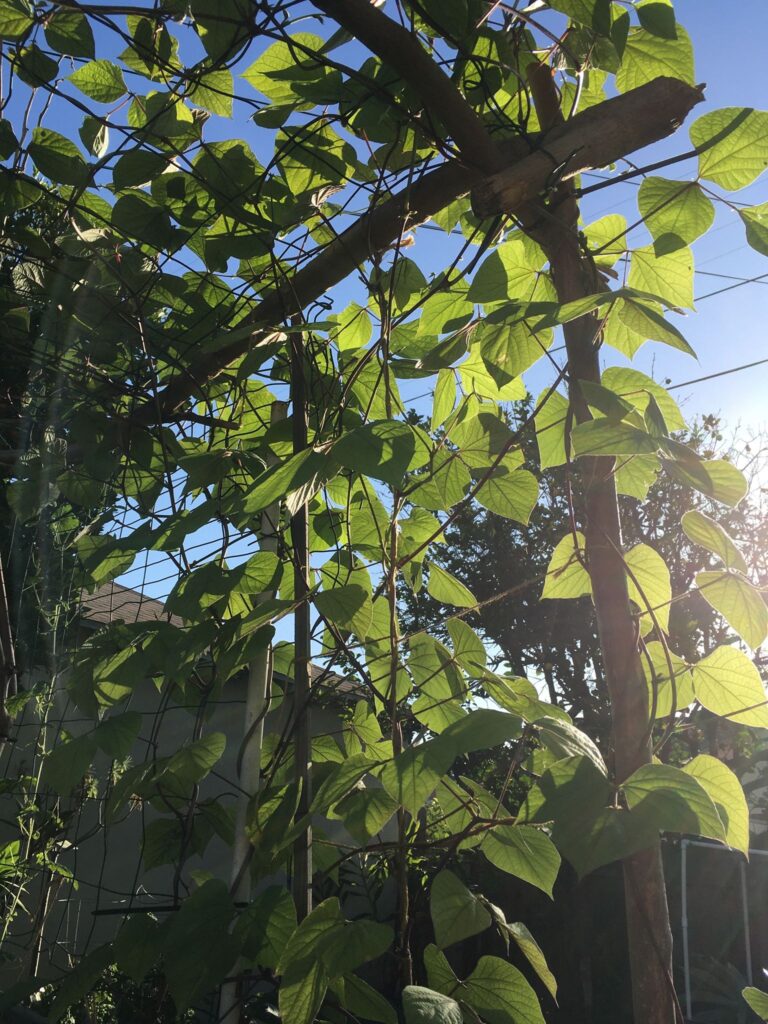
Realizing her life’s purpose
Her first job was at ARCO as a secretary. She kept many balls in the air: a wife, a full-time worker, a mom, and an activist advocating for the return of human rights and democracy in the Philippines.
On weekends, she wrote newsletters, chaired meetings for the Anti-Martial Law Coalition (AMLC) and cooked for hundreds. She learned how to write press releases and do media briefings and attended the Far West Conventions held in Seattle, San Diego, Los Angeles and San Francisco.
Still, she persisted and took night classes for 14 years. She completed her B.S. degree in business administration from the University of Redlands in 1987. In 1996, she earned her Master’s degree in urban planning at UCLA, where she also completed her academic coursework towards a Ph.D.
At UCLA, she worked with the Chicano Studies Department’s Professor Abel Valenzuela and did research on day laborers, men who assembled on street corners, waiting and ready to be hired for the day. At truck stops, a group runs to the driver, seeking day jobs. Some met accidents, necessitating this study to be commissioned.
Carol met with day laborers at the crack of dawn. Their research findings helped in establishing the need for a Day Labor Center, and now, day hires can be facilitated, and with dignity to them. For this collaboration, she got a service award from the Coalition for Humane Immigrant Rights of Los Angeles (CHIRLA), presented to her by the day laborers she helped.
Just like a gardener, she weeds the soil out of injustice and prepares it to grow for the next growth season.
For the day laborers, her efforts led to greater dignity in looking for day jobs, and in the future, a job with living wages.

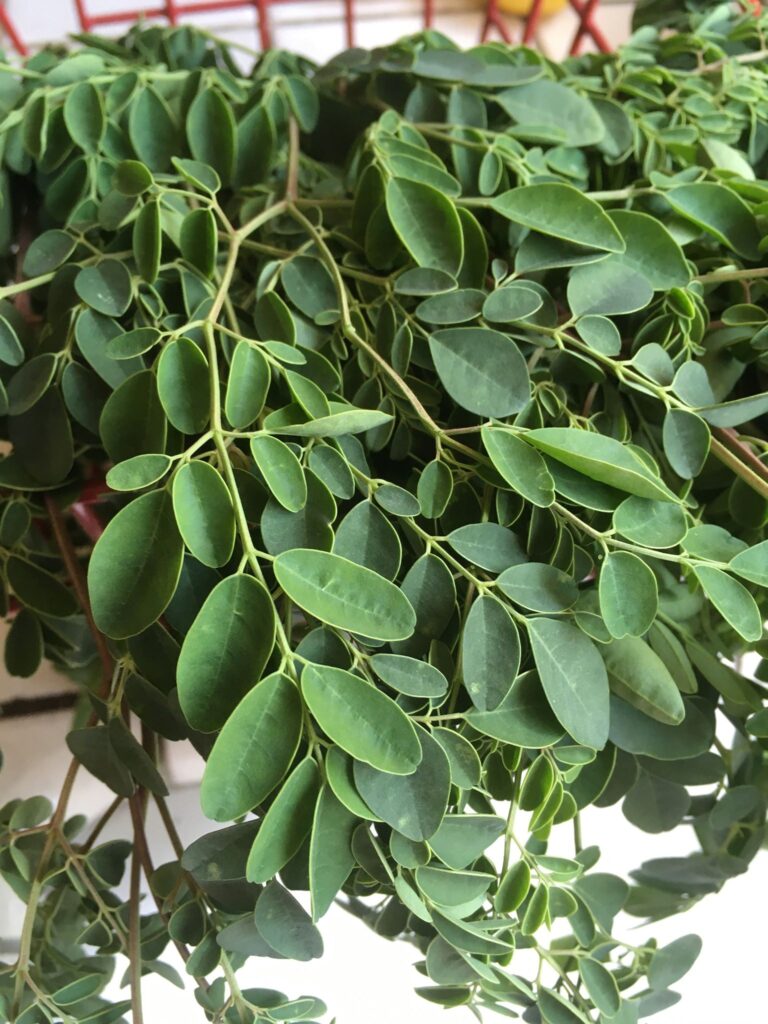
A strong believer in the community and academe connection
Critics of higher education have criticized professors in the ivory tower, much removed and rendered irrelevant without community connections. Carol strongly believes in a life in academe linked to strong community ties.
She has served on boards of non-profits: Search to Involve Pilipino-Americans, the Filipino American Library, and as a Humanities Advisor for FilAm Arts’ Saysay Project.
She was recruited to serve on the Economic and Efficiency Commission of LA County by then Board of Supervisor Gloria Molina. While a commissioner, the task force studied the jury system and it led to current practices now of one trial or one-day appearance with an increase in stipend from $5 to $15/day. Previously, jurors would sit for days and weeks, losing pay, waiting to be called for a trial. The commission also studied allegations of police brutality at the sheriff’s but their recommendations did not lead to reform. She served on that commission for eight years.
She also served as Commissioner of LA County’s Public Social Services for 16 years and in the San Gabriel Planning Commission for six years. Her volunteer job required refresher courses in ethics and sexual harassment and she served without compensation, pro bono.
She credits her husband for helping her figure things out, “he is a good sounding board,” and it enables her to use her voice, seek help from others, and get over any bitterness to simply enjoy life.
Diversity in her family
She met David, whom she described as “guapo, appealing eyes and kind,” at a rally. She soon realized their common bond as peace advocates. Their love has taken them to road trips and camping with the kids, preferring to take the back roads, to see the countryside, family get-togethers, celebrations of summer birthdays, and lots of friends coming over to watch the Rose Parade every January 1.
When asked how they managed to make their union last, she said, “by making each other laugh, by enjoying each other’s company, instead of fighting. One time, Koga, our cat became the referee, she meowed until we stopped our loud voices.”
On her grandbaby, “I re-learn patience. When I had kids, I was patient. With my apo, she gets it right away and she makes me laugh. When she was having tantrums, I simply said, ‘You are not having a good day,’ and then she pointed to a cookie that she wants and later, an area to explore. She puts a whole calamansi her mouth and I let her. When I have music on, she moves with rhythm. I have learned to go by her pace, a slower pace, and match it with music, dancing and laughing. We do not look at what future brings, but I look at T, that’s how the future looks.”
Her grandchild is a hybrid of Mexican, Filipino and Caucasian races. “In her, diverse nationalities have fused together in her blood and genes, and she exudes all these strengths: smarts, tenderness, affectionate, rhythmic movements, and multiple languages of Spanish, Tagalog and English.”
Carol’s aloha-full life is akin to the ‘beyond the roof line’ bay leaf tree, as she has literally planted good seeds in many places in Los Angeles, Historic Filipinotown, San Gabriel Valley, Fullerton and Irvine. Good seeds of love for her community, care for the environment and sustained sharing of her insights and knowledge.
Her home percolates on warmth and compassion, much like the warm tones of the fabric we saw wrapped with the silver plated gongs to play kulintang music with.
The resonance of her aloha is loud and clear!
Published on Asian Journal
Updates: This article was published in 2016. Many thanks to Carol Ojeda-Kimbrough who shared these updates, much of what we need during this #CoronaVirus
After spending the last 3 years fuming, commenting, cursing, and marching against mean-spirited and corrupt policies of this administration, I started to look forward to 2020 as the year when we could finally undo the damage this man and the Republican Party has done to America.
We had very ambitious plans for 2020, all involving a combination of travel with politics – starting with going to New Orleans in March and driving north and east from NOLA on a route that would take us to Mississippi, Tennessee, Alabama, Georgia and South Carolina. We had planned on going to Carbon Hill in Alabama, where David’s family came from, followed by a stopover in Atlanta, GA to visit the Fair Fight offices (and hopefully meet Stacy Abrams) to see if we can return and volunteer during the November general elections, and finally, visiting our dear friends Cris Harris and Nannette Perez in Marietta, GA before we all continue together to either Savannah, GA or Charleston, SC. I was very excited about this trip, as I’ve never been to these States before.
After, we had also planned on a week’s vacation in Kauai in late April or early May, and doing volunteer GOTV work in either Nevada or Arizona shortly after.
However, by the time I was feeling well from influenza, enough to reschedule our travel plans, the spectre of COVID-19 has captured the country’s attention and without any federal plan or leadership, the State of CA issued a mandatory statewide stay-at-home order.
Well, that was the end of our 2020 travel plans. So what does that have to do with my gardening? Having meticulously planned to not be home for most of the year, I let the backyard area fallow, figuring it could use a vacation as well while we were out of town.
But when Gov. Newsom and other LA County/City officials ordered shelter-at-home and other public health measures, I knew there would not be any travelling happening anytime soon.
David was in charge of water quality for a big city in the SG Valley, and as an essential worker, he had to report to work daily. In the meantime, due to this pandemic, I lost my job babysitting my youngest grandchild, one of my two greatest sources of happiness. I was left home alone to ponder what’s next.
This is how I came to the idea of doing a major project in the backyard, as late as it was for spring planting, and see what can be accomplished. Fortunately, during the winter, I had covered much of the planting area with large cardboard sheets and layered leaves, wood chips and other compostable materials on top of the cardboards.
I learned this practice of “sheet mulching” or lasagna composting from a good friend who is a certified Master Gardener. By doing this and leaving it alone to decompose for a year, I thought I’d have a very rich soil built for 2021 planting.
While it wasn’t completely ready, I decided to go ahead. I started by building two garden beds, one 8’ x 4’ and the other 4’ x 4’. Not satisfied with that I also built a new trellis made out of cut malunggay branches, PVC pipes, zip ties, twine and other materials.
I decided to place the trellis just south of the large calamansi tree and make it wide enough to fit two children’s Adirondack chairs (where my grandkids can sit, read books, observe nature or just meditate). I imagined the vines that would grow along the trellis would provide a “hunting blind” so that the girls and I can freely observe birds, squirrels, or lizards (and take photographs) without being detected.
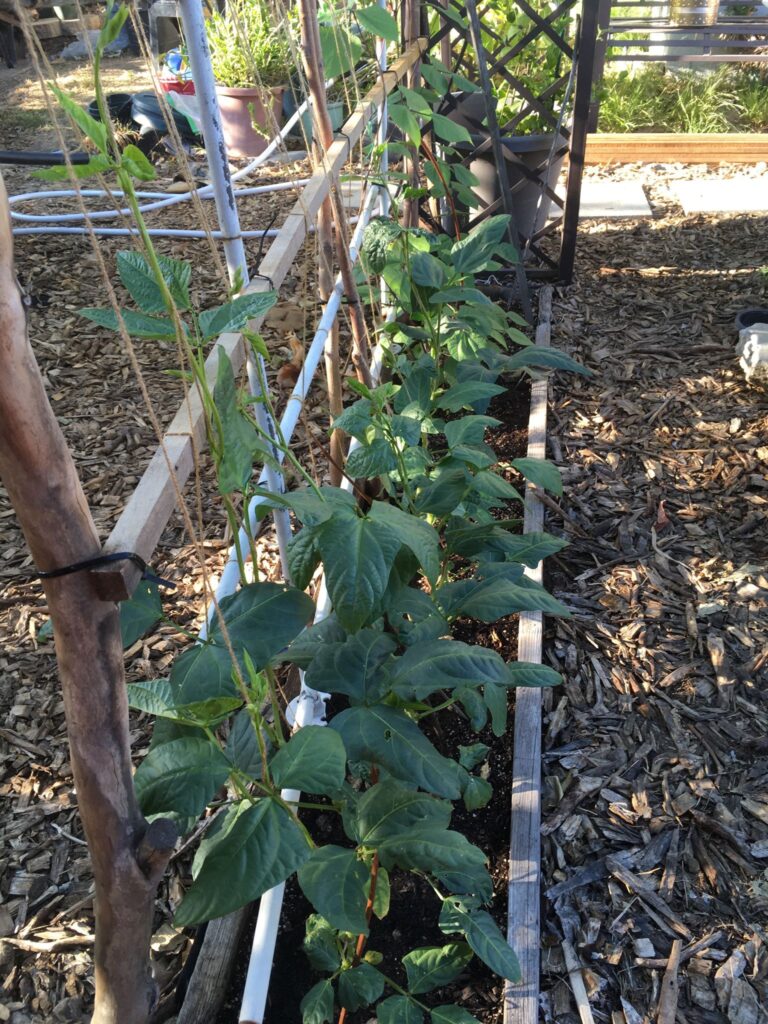
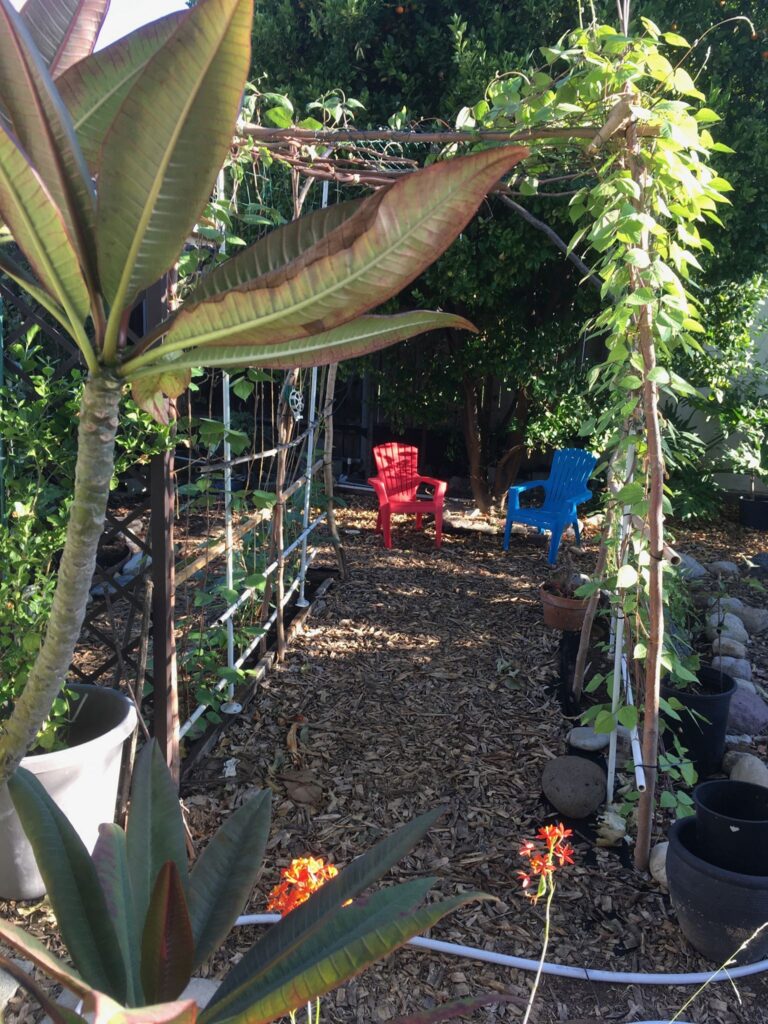
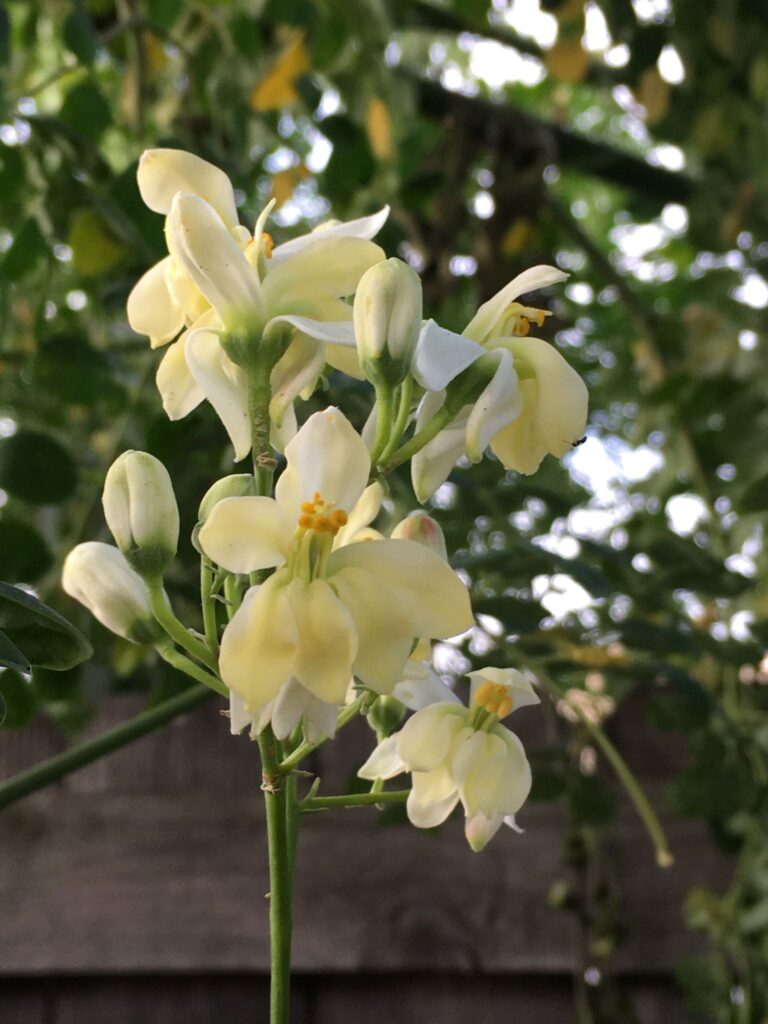
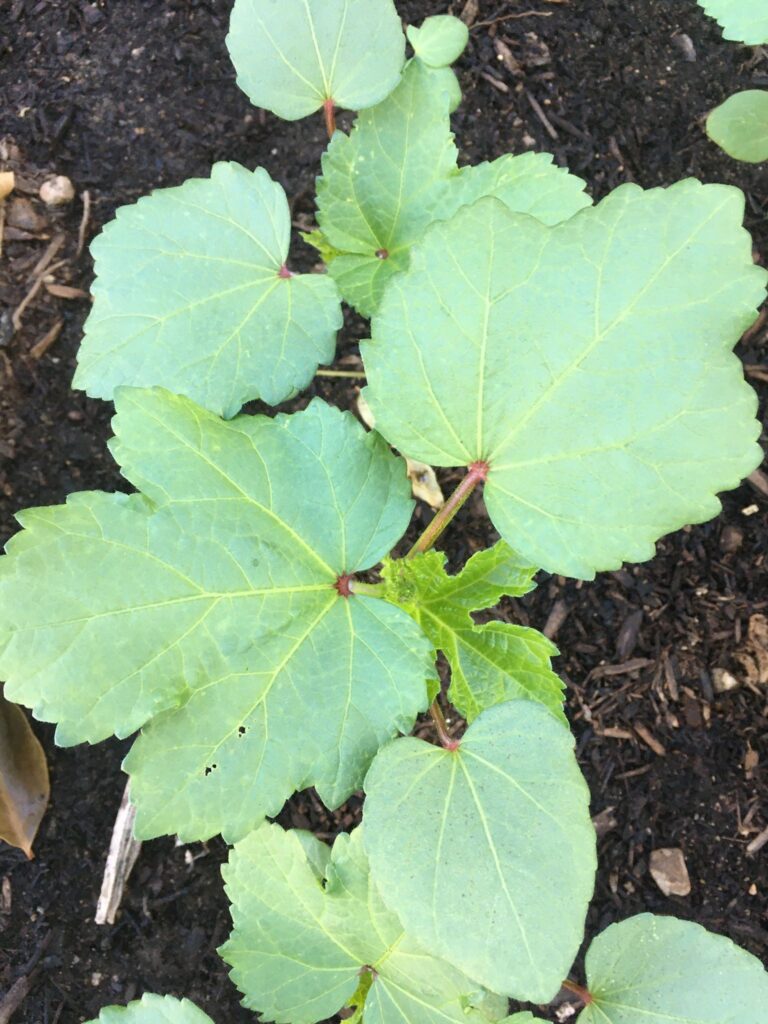
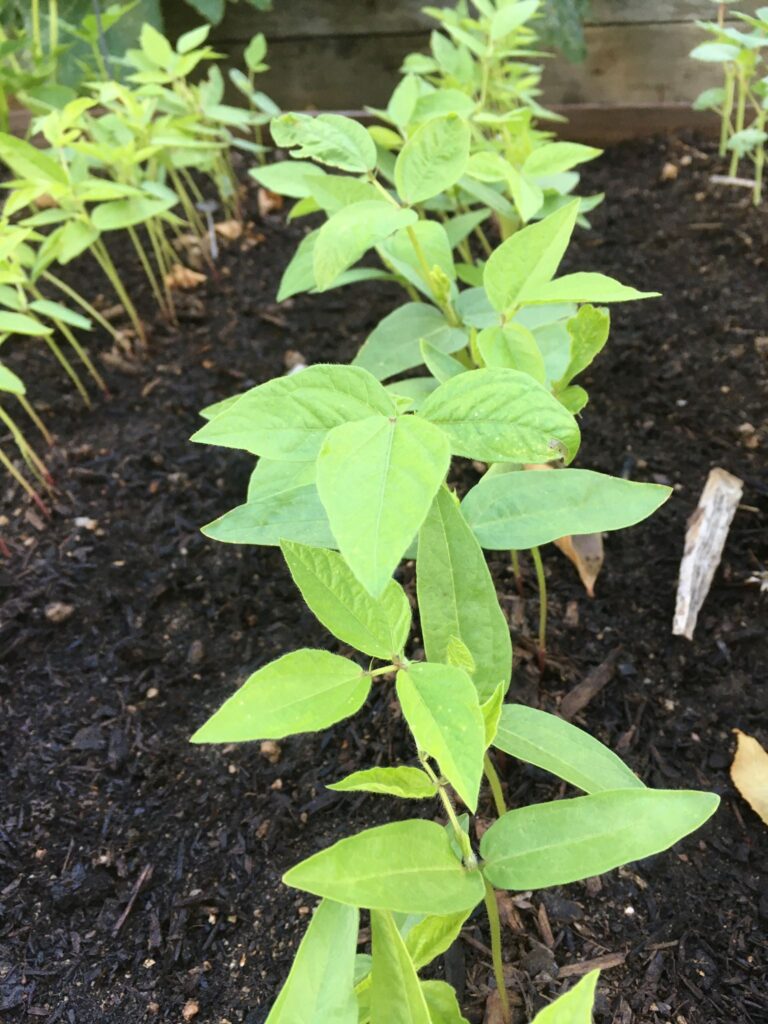
Here are before and after pictures of the backyard as well as pictures of what I was able to plant in late May.
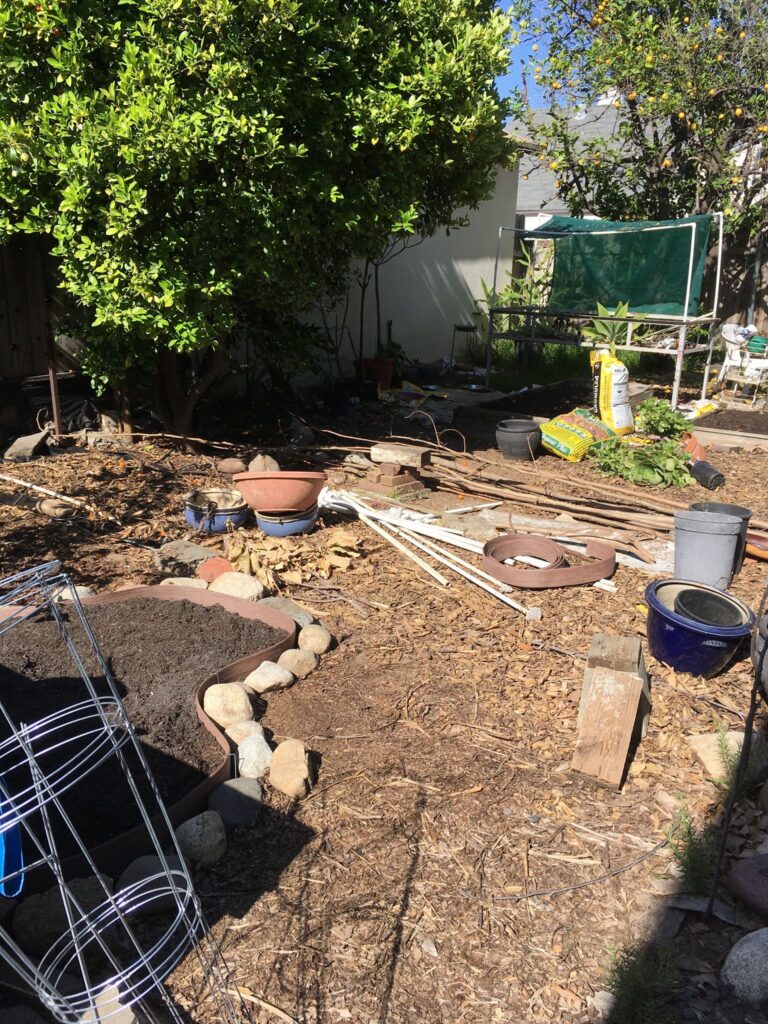
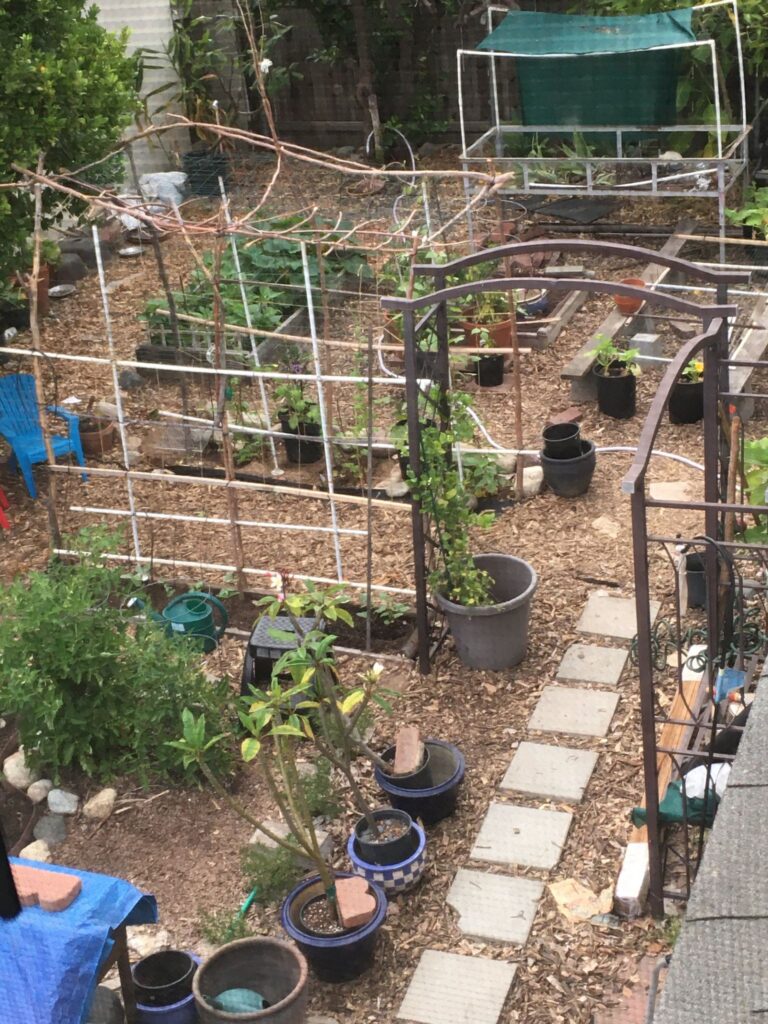
I also included pictures of visitors – a parrot and a peacock !! We are lucky to live in SoCal where we have a long planting season, almost year-round even.
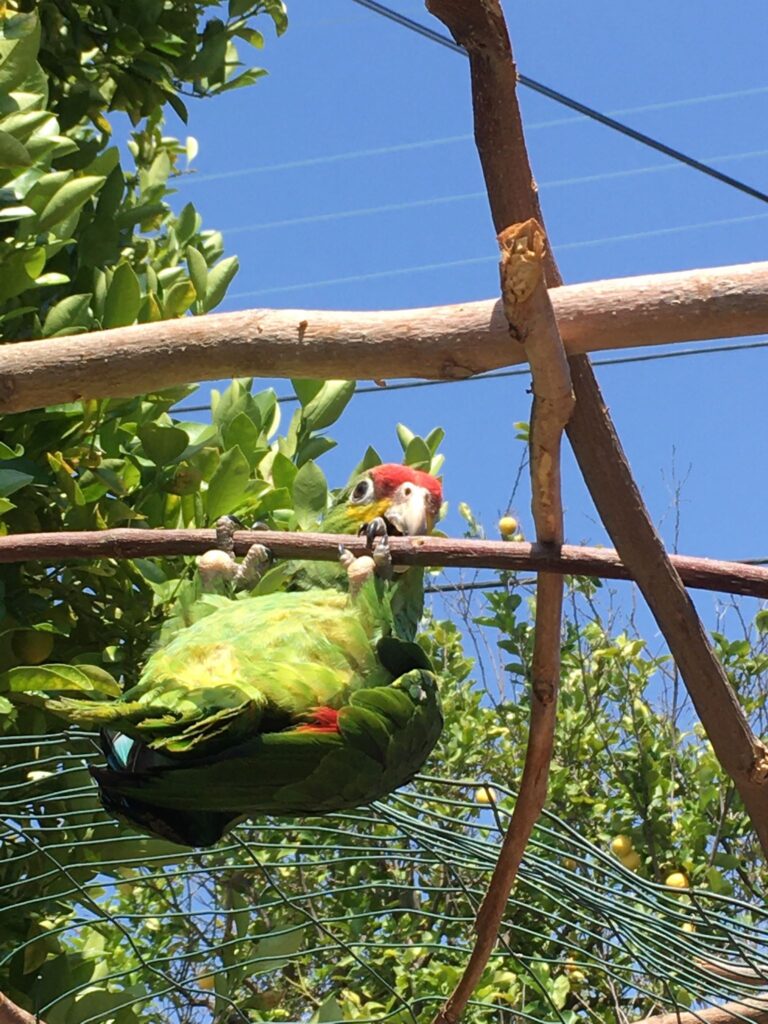
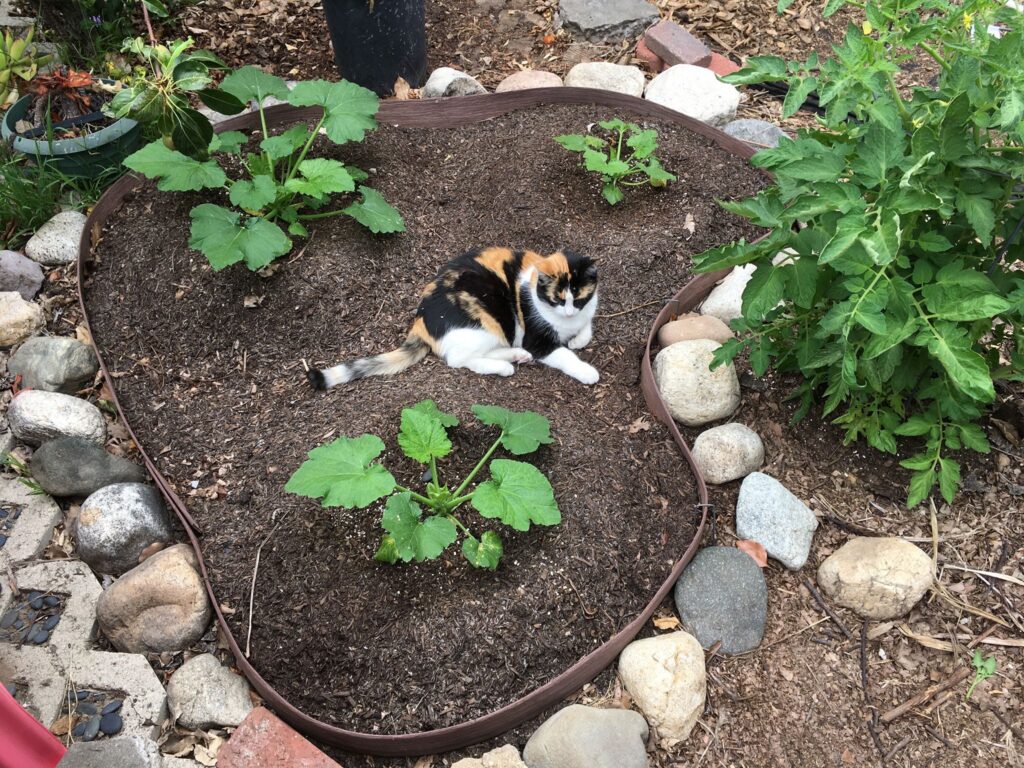
Still in progress are benches with the girls’ names and an art area where they can let their imagination run with whatever medium they wish to use – T is a dancer and visual artist while S is very much into singing and acting. But most importantly, I am preparing for the day when they can again spend precious time with Lolo and Lola.
During this time, I also created an FB group called Creative Cooking During the Pandemic where friends can help each other figure out what to cook – which isn’t easy to do if this has not been your routine in a while. I have learned so much from this circle of friends who are now into wild yeast and sourdough bread baking, vegetarian and vegan cooking, and my favorite, rainbow cooking.

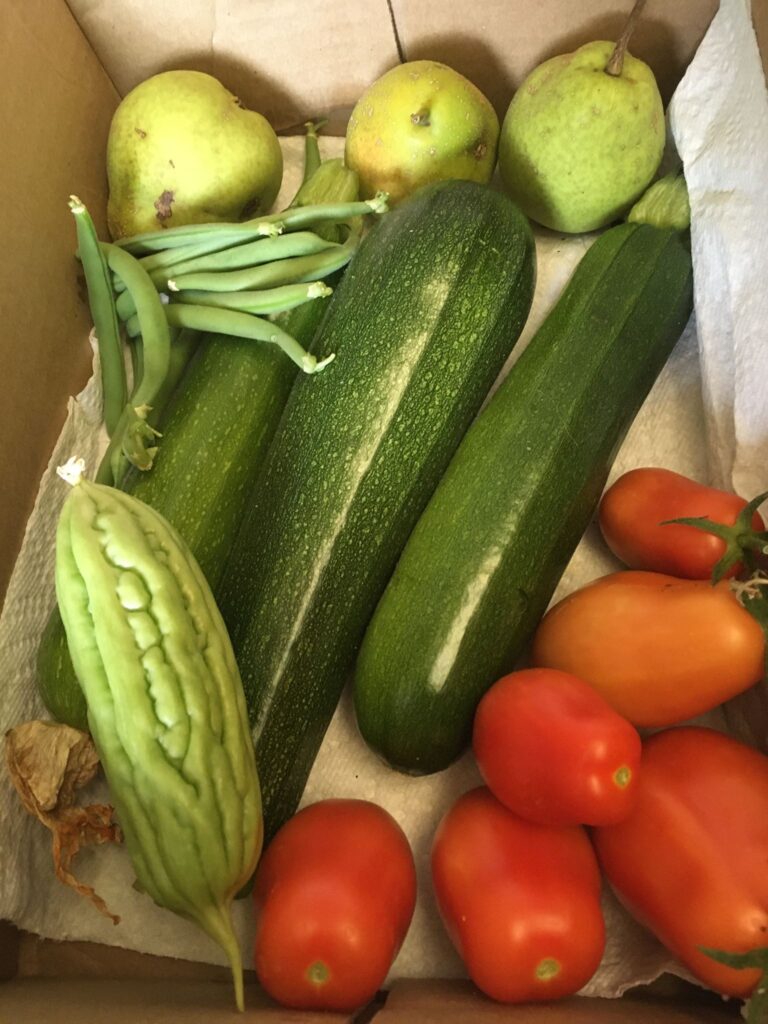

I am hoping that the coming election will result in a more humane and accountable administration, one that will put people first before profits, that will put an end to systemic racism, and that will demilitarize and address police violence against our black brothers and sisters.
That is my hope, but I am also realistic enough to know that we will be facing an uphill battle against the pandemic and rebuilding the economy from the ravages of unfettered capitalist greed and blatant racism unleashed by Trump.”
